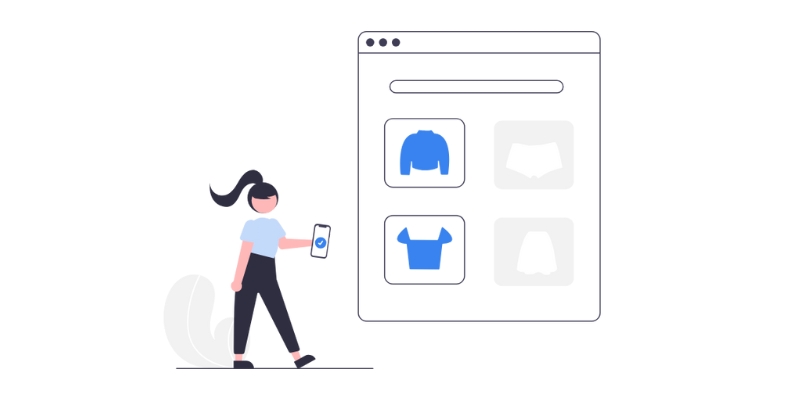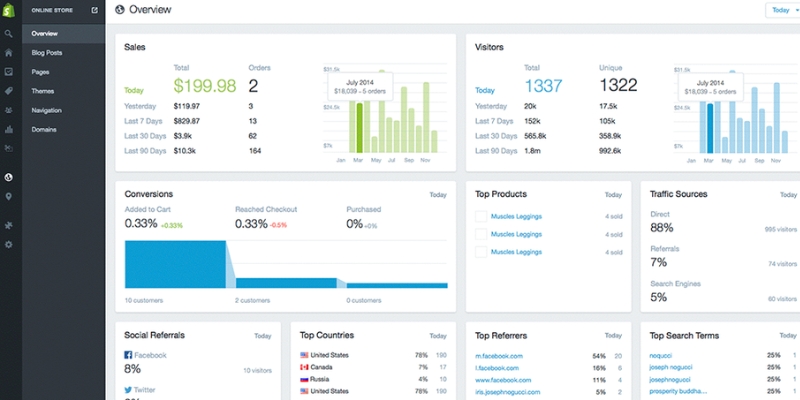Lucia Lee
Last update: 02/10/2025
For those looking to start up their ecommerce business, the barriers to entry - from storefront design to payments - can feel overwhelming. But it doesn’t have to be that way. With SaaS ecommerce, you can launch your online store quickly without worrying about the heavy technical lifting that usually comes with building and maintaining complex systems from scratch. So, what exactly is SaaS ecommerce, how does it work, and what advantages and drawbacks does it bring? Keep reading to discover why it’s becoming the go-to model for ambitious brands that want to grow smarter, not harder.
SaaS ecommerce refers to an online store platform that operates on cloud-based solutions, allowing businesses to sell products without the hassle of downloading or managing complex software. Instead of handling servers, updates, and security on their own, merchants simply log in from any device with an internet connection and start running their store. The SaaS provider takes care of hosting, maintenance, and upgrades behind the scenes.
How does SaaS ecommerce work?
This model is typically offered through a subscription model, where businesses pay a recurring fee - monthly or annually - for access to the software and its features. In return, they get a streamlined, cost-effective way to launch and scale their ecommerce operations. With built-in templates, add-ons, and ready-to-use tools, SaaS ecommerce removes technology hurdles and enables brands to focus on growth, customer experience, and sales rather than IT headaches.
SaaS ecommerce is a growing trend in the ecommerce world, but just like any business model, it comes with a set of pros and cons that you need to consider before making the final decision.
SaaS ecommerce platforms bring a wide range of benefits that help businesses of all sizes launch, manage, and scale their online stores more efficiently. Let’s take a closer look at what they bring to the table:
Low upfront costs & predictable expenses
Unlike traditional ecommerce setups that require large investments in servers, hosting, and custom development, SaaS platforms operate on a subscription basis. This eliminates heavy initial expenses and replaces them with a predictable monthly or yearly fee. You can also avoid hidden costs tied to maintenance, upgrades, or infrastructure, making budgeting much easier.

Low upfront costs
Hassle-free maintenance
With SaaS ecommerce, the provider takes care of all the backend tasks - from bug fixes and hosting to regular software improvements. You don’t need a full IT team to keep your store running smoothly. Automated updates ensure your platform always has the latest features, security patches, and performance enhancements without downtime or extra effort.
Scalable infrastructure for growth
As your sales and traffic grow, your platform needs to keep up. SaaS platforms are built on scalable infrastructure, meaning they can handle sudden traffic spikes, seasonal surges, or global expansion without crashing. You can easily upgrade your plan, add new features, or expand into new markets without having to rebuild your system.
Strong security protocols
Security is a major concern for any online business, and it can be challenging if you handle it yourself. SaaS ecommerce providers are responsible for this, often investing heavily in security protocols like PCI compliance, encryption, fraud detection, and SSL certificates to safeguard customer data. This not only builds trust with shoppers but also reduces the burden of cybersecurity management on your business.
Easy setup & user-friendly interface
SaaS ecommerce platforms are designed for accessibility. You don’t need to write a single code as they come pre-equipped with drag-and-drop editors, pre-designed templates, and guided setup that help you easily create a professional-looking storefront in hours. Even non-technical users can set up a store, update content, add products, and customize layouts without much difficulty.

Easy setup & user-friendly interface
Built-in merchant services & integrated payment gateways
Most SaaS ecommerce platforms come with built-in merchant services like tax calculations, fraud protection, and payment processing, helping you manage your store more easily. Payment gateways are also seamlessly integrated, allowing customers to pay via credit card, PayPal, digital wallets, or even buy-now-pay-later options - all within a secure environment. This makes checkout faster, safer, and more convenient for customers, increasing their likelihood of coming back for more purchases.
Multi-layered inventory management
Managing stock across multiple sales channels can be complex. However, this doesn’t need to be a headache if you use SaaS ecommerce platforms. With integrated inventory management features that sync product availability in real time, you can prevent overselling, streamline order fulfillment, and scale your business without losing control of their stock.
Advanced analytics and reporting
Modern SaaS platforms provide powerful analytics and reporting dashboards that give insights into customer behavior, sales trends, and marketing performance. You can track key metrics like conversion rates, average order value, and customer lifetime value, making data-driven decisions easier than ever.
Built-in customer relationship management (CRM) tools
Customer loyalty is the backbone of ecommerce success. Many SaaS platforms include customer relationship management features such as automated email campaigns, personalized product recommendations, and segmentation tools. You can leverage these tools to strengthen customer engagement and increase repeat purchases.
Flexible third-party integrations
SaaS platforms are designed to connect seamlessly with other tools, from shipping software and accounting systems to marketing automation and ERP. These third-party integrations streamline workflows, eliminate data silos, and create a more efficient ecosystem for your business operations.
Multi-channel sales capabilities
Today’s customers shop across websites, social media, and marketplaces. SaaS eCommerce platforms make it easy to expand through multi-channel sales, syncing your product listings with platforms like Amazon, eBay, Facebook, and Instagram. This not only widens your reach but also creates a consistent shopping experience across channels.
While SaaS ecommerce platforms provide convenience and scalability, they also come with certain limitations that businesses should weigh carefully before committing.
Limited customization and flexibility
That SaaS platforms provide prebuilt templates and standardized features can be a double-edged sword. It streamlines setup but limits creative freedom, making it not the best choice for businesses with highly unique requirements or complex back-end processes. Development teams typically cannot alter the core codebase, meaning the platform may not fully align with a brand’s specific vision or customer experience goals.
Ongoing subscription costs
The subscription model makes SaaS ecommerce affordable at first, but costs can accumulate over time. As businesses scale, they may need to move into higher-tier plans or purchase add-ons, driving expenses up significantly. For fast-growing companies, monthly or revenue-based pricing structures can begin to feel like a financial burden compared to the predictability of owning custom-built infrastructure.

Ongoing subscription costs
Data ownership and vendor lock-in
Since SaaS providers host customer and business data on their servers, companies give away a degree of control. Migrating to a different platform can be time-consuming and technically challenging, creating a form of vendor lock-in. If your business is tied too closely to a provider’s ecosystem, you may find it costly and disruptive to switch solutions as new technologies emerge or strategic needs shift.
Also read: Ecommerce Platform Migration: Everything You Need To Know
Security and data protection concerns
Although SaaS providers invest in robust security protocols, storing sensitive data offsite inherently carries risk. Cybercriminals may target centralized data centers, while unsecured employee devices or third-party access can introduce vulnerabilities. You must trust your provider to comply with regulations like GDPR and PCI DSS - but some vendors may not meet every company’s internal security standards.
Connectivity dependence and potential performance issues
Because SaaS ecommerce platforms are fully internet-dependent, a stable connection is essential. Any outage, latency, or slow internet speeds can directly impact sales and customer experience. While reputable providers use scalable infrastructure to minimize downtime, smaller vendors may still struggle to deliver consistently fast load times under high traffic conditions.
Hidden complexity in scaling
Scaling a SaaS-powered business isn’t always seamless. As order volumes increase, companies may need more technical support, additional SaaS solutions, or expanded staff to manage the growing system. These scaling challenges can add operational complexity and eat into profit margins, especially if the chosen platform doesn’t evolve as quickly as the business itself.
Limited integration options for niche needs
Most SaaS ecommerce platforms offer a wide selection of third-party apps, but businesses with highly specialized requirements may struggle to find compatible tools. This can restrict innovation, slow down workflows, and force compromises in customer experience. In contrast, custom-built systems allow businesses to integrate precisely what they need without vendor restrictions.
The SaaS ecommerce space is filled with platforms catering to different business sizes and goals. While each comes with its strengths, some solutions are better optimized for growth, scalability, and long-term performance. Let’s take a closer look at the most notable platforms available today.
Shopify
Shopify is one of the most popular SaaS ecommerce providers, powering more than five million online stores worldwide. Known for its wide variety of templates and ease of setup, Shopify makes launching a store straightforward for both beginners and experienced merchants.

Shopify
With a vast app marketplace of over 13,000 integrations, Shopify enables businesses to connect with payment processors, billing systems, and third-party platforms. Its features include abandoned cart recovery, multichannel selling on social media, and even headless functionality for brands seeking advanced performance and flexibility.
BettaMax
Among the new generation of SaaS ecommerce platforms, BettaMax stands out as one of the fastest-growing and most innovative solutions. Designed for speed, intelligence, and automation, BettaMax equips businesses with everything they need to thrive in competitive digital markets.
Its no-code website builder allows sellers to create professional, highly customizable storefronts in minutes through a simple drag-and-drop interface. Beyond design, BettaMax takes ecommerce a step further with AI-powered inventory management, real-time analytics, and automated marketing tools that help merchants optimize operations and boost conversions effortlessly. Personalized shopping experiences are driven by AI-driven recommendations, while integrated AI customer support ensures businesses can deliver consistent, 24/7 service at scale.
For growing brands looking not just to launch but to scale quickly and intelligently, BettaMax provides an all-in-one ecosystem that reduces complexity and maximizes efficiency. Its combination of automation, personalization, and scalability makes it an ideal choice for ambitious businesses aiming to dominate their markets.
BigCommerce
BigCommerce is an open SaaS ecommerce solution designed for mid-market and enterprise-level brands. It combines the benefits of multi-tenant SaaS - fast deployment, low ownership costs, and built-in hosting with APIs that allow deeper customization and integration with external applications.
BigCommerce offers an intuitive PageBuilder that provides a drag-and-drop editing experience, making it possible to design professional websites without coding. Both B2B and B2C companies across 150 countries rely on BigCommerce to deliver engaging customer experiences and scale internationally.
Squarespace
Initially popular among creatives for its visually appealing templates, Squarespace has expanded into ecommerce through its Squarespace Commerce offering. It appeals to small businesses and artists who want to showcase products with strong visual storytelling. The platform supports omnichannel selling by integrating with social media channels and enabling in-person transactions. However, its app marketplace (Squarespace Extensions) is limited compared to competitors, and payment options are restricted to Stripe, PayPal, and Square.
Wix
Wix is primarily known as a website builder but also offers ecommerce features. Its drag-and-drop editor makes it accessible for beginners, particularly small businesses that want to get online quickly without technical skills. That said, Wix’s ecommerce functionality is somewhat secondary, with challenges around advanced customization, mobile optimization, and website performance. For businesses aiming to scale significantly, these limitations may require switching to a more robust platform down the line.
As SaaS ecommerce continues to grow, providers are under pressure to deliver platforms that are secure, scalable, and seamlessly connected. These challenges aren’t just technical hurdles - they directly impact customer trust, platform performance, and long-term growth. Here are three of the most pressing challenges of SaaS ecommerce.
Security and compliance pressures
Data protection has become the frontline issue for SaaS businesses. With regulations such as GDPR in Europe and CCPA in California, providers must ensure airtight privacy safeguards across their platforms. At the same time, cyberattacks are growing more advanced, targeting vulnerabilities in cloud infrastructure and multi-tenant systems. The challenge lies in maintaining strong data isolation so that one customer’s environment cannot be compromised by another’s. On top of this, global ecommerce players must often comply with region-specific storage requirements, adding another layer of architectural complexity.

Security and compliance pressures
Scaling without performance trade-offs
Rapid growth is a good problem to have, but it brings performance headaches. A sudden traffic spike during holiday sales or viral campaigns can overwhelm databases, APIs, or payment gateways, causing downtime at the worst possible moment. To avoid this, SaaS platforms need to invest in load balancing, caching solutions, and database sharding to distribute workloads effectively. Cloud services offer auto-scaling, but without careful cost management, expenses can balloon quickly.
The rise of microservices also complicates matters: a poorly optimized component can slow down the entire system. Add in the expectation of sub-second response times from global customers, and the need for edge computing or CDNs becomes clear. The winning platforms will be those that scale smoothly while balancing cost, speed, and resilience.
Managing integration complexity
Modern SaaS ecommerce platforms rarely operate in isolation - they depend on a growing ecosystem of third-party APIs for payments, CRM, marketing automation, and more. But every dependency introduces fragility. A change in something as simple as an OAuth flow can break integrations overnight, disrupting business operations.
To combat this, providers must design fault-tolerant systems with retry logic, circuit breakers, API gateways, and careful version control. Backward compatibility is also essential: new features should roll out in stages to avoid disrupting existing users. For enterprise clients, the stakes are even higher since integrations often require custom code, adding to long-term maintenance overhead. The only sustainable way forward is through robust CI/CD pipelines, automated testing, and proactive monitoring.
SaaS ecommerce is moving into a new era - one defined less by endless features and more by measurable outcomes, automation, and trust. For businesses, this shift isn’t just about adopting new software; it’s about rethinking how digital tools drive real-world results.
From features to outcomes
In the past, SaaS platforms competed by adding as many features as possible. But the landscape is now saturated, and most businesses use only a fraction of the tools they pay for. The real question has become: Which platform delivers results with the least friction? Future-ready SaaS providers are pivoting to outcome-based pricing models, where success is measured by reduced churn, higher conversions, and faster operations - not logins or dashboards. For ecommerce brands, this means investing in platforms that directly improve sales and customer retention rather than overwhelming teams with unused functions.
The rise of AI-driven, invisible software
The next generation of SaaS won’t require users to live inside dashboards. Instead, AI-driven solutions and intelligent agents will handle the work behind the scenes, surfacing only what matters.
Imagine an ecommerce manager no longer logging into multiple systems to process orders, check shipping rates, or update inventory. Instead, the software automatically makes decisions - choosing carriers, managing stock, and alerting the team only if something goes wrong. This shift toward invisible UI is powered by advanced machine learning and AI models that automate processes, streamline workflows, and generate insights without manual intervention.
Trust, transparency, and control
As AI takes on a more autonomous role, businesses will demand visibility into how decisions are made. Trust will hinge on platforms that explain actions in plain language (e.g., “Reallocated inventory to avoid stockouts based on forecasted demand”), provide logs and override options, and prioritize security. With ecommerce brands handling sensitive customer data, robust cloud infrastructure, bias mitigation, and compliance safeguards will be non-negotiable. The SaaS companies that strike the right balance between automation and transparency will earn long-term loyalty.
SaaS ecommerce is becoming the foundation for how modern businesses launch, scale, and compete online. From faster go-to-market times to reduced operational costs and continuous innovation, it equips retailers with the flexibility they need to stay ahead in an ever-changing market.
If you’re ready to unlock growth with a platform built for scalability, security, and seamless integrations, Sky Solution’s SaaS ecommerce platform and end-to-end ecommerce solutions are here to help. Our platform BettaMax comes fully equipped with AI-powered tools, seamless integrations, and a ready-to-use design optimized for sales conversion. Let’s build the future of your online store together. Contact us now for a free consultation!